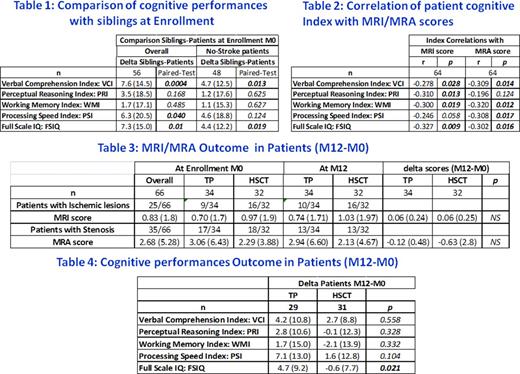Abstract
Background: "Drepagreffe" is a French national prospective trial involving 67 sickle cell anemia (SCA)-children with a history of abnormal cerebral arterial velocities by TCD, and comparing for the first time the outcome of cerebral vasculopathy following transfusion program (TP) or transplantation (HSCT). Inclusion criteria at enrollment were children with SCA (SS/Sb0), younger than 15 years, with a history of abnormal cerebral arterial velocities (TAMMX ≥ 200 cm/sec) and placed on long-term TP, with at least one non-SCA sibling, and with parents accepting HLA-typing and HSCT if a genoidentical donor was available. The 2 arms (TP/HSCT) were defined by the random-availability of a genoidentical donor. Seven of the 67 patients had a history of stroke. Transplanted patients (n=32) received a conditioning regimen of Busilvex-CY 200 mg/kg and 20 mg/kg rabbit Thymoglobulin, with CSA and a short course of MTX or MMF for GvHD prophylaxis. In the TP arm (n=35), HbS% was maintained at < 30%, with an Hb at 9-11g/dL. At enrollment and 12 months post-enrollment, blood screening, Doppler, and cerebral MRI/MRA were performed along with cognitive performance testing, the latter being done in parallel in the non-SCA siblings. Preliminary findings on cerebral velocities as the primary endpoint were reported at the last ASH meeting (abstract 67237), and demonstrated that all patients were alive at one year and that the 32 transplanted patients had no chronic GVHD and the same hemoglobin profile as their donor. Velocities were significantly lower post-HSCT than under TP (p <0.001), and were normalized in a greater number of patients (p =0.003).
Patients and Methods: We report here the cerebral imaging (MRI/MRA) and cognitive performance data performed at enrollment and after 12 months. The scoring applied for MRI was: 3 = territorial, 2 = borderzone (cortical and subcortical), 1 = white matter or basal ganglia infarcts, 0 to 3 = atrophia, and for MRA: 1 = mild stenosis (25-49%), 2 = moderate stenosis (50-74%), 3 = severe stenosis (75-99%), 4 = occlusion for each artery and 0 to 2 for Moya presence. Cognitive testing using the WPPSI-3 (3-6 yr), WISC-4 (7-16 yr) or WAIS-3 (>16 yr) scales, depending on the age, was performed in patients and in siblings when possible.
Results: MRI/MRA data were available in 66/67 patients. At enrollment (M0), ischemic lesions and stenoses were present in 25 and 35/66 patients, respectively. Cognitive testing was obtained in 64 patients and 56 siblings. Paired analysis with siblings (Table 1) showed significant differences in Verbal Comprehension Index (VCI) with a mean difference of 7.6±14.5(p =0.0004), Processing Speed Index (PSI) 6.3±20.5 (p =0.04), and Full Scale IQ (FSIQ) 7.3±15.0 (p =0.01). After exclusion of the 7 patients with stroke history, significant differences were still observed in VCI (p =0.013) and FSIQ (p =0.019). Patient cognitive performance indexes were correlated negatively and significantly with the MRI and MRA scores (Table 2). At post-enrollment (M12),ischemic lesions and stenoses were present in 26/66 patients. The mean variation in MRI and MRA scores between M12 and M0 was not significantly different between the 2 arms (Table 3). The cognitive tests were performed at M12 in 60 patients (Table 4) and the performance indexes were improved in the TP compared to the HSCT arm, but only significantly for FSIQ.
Conclusion This first prospective trial initially showed that HSCT reduces more significantly the cerebral velocities at M12 and in a higher proportion of patients than TP. Here, we show that patients with a history of abnormal cerebral velocities had significantly lower cognitive performances than their siblings, even in the absence of stroke history; however, there was no significant difference between the 2 arms for the outcomes of ischemic lesions and stenosis at M0 and M12. The fact that cognitive performances were improved in the TP compared to the HSCT arm might be explained by the stress of the HSCT procedure and the lack of schooling during this period. Despite the higher ability of HSCT to decrease velocities at M12 compared to TP, a longer follow-up will be required to demonstrate its effect on stenosis and cognitive performances; therefore, patients will be reassessed at 3 years post-HSCT.
Bernaudin:Novartis: Research Funding.
Author notes
Asterisk with author names denotes non-ASH members.


This feature is available to Subscribers Only
Sign In or Create an Account Close Modal